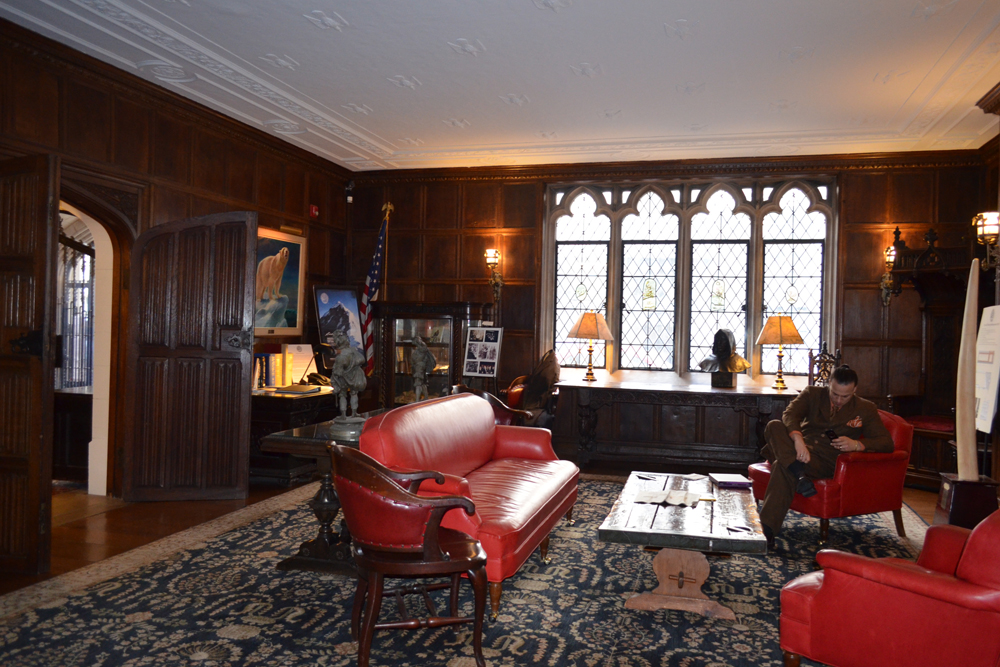Behind the Scenes at NYC's Exclusive Explorers Club

NEW YORK — Taxidermied animal heads, majestic elephant tusks and even a preserved whale penis adorn the walls and rooms of the Explorers Club. This exclusive society, based here on the Upper East Side of Manhattan, is open only to members who've sailed to new shores, climbed to new heights or trekked on new paths. In other words, real explorers.
A recent tour of the club's headquarters revealed a hidden enclave packed floor to ceiling with mementos of brave expeditions over the years.
In the entrance hall is a photo, a flag and a letter from the crew of Apollo 15, who carried the flag with them on their journey to the moon in 1971. Nearby is a signed photo from the crew of the Bathyscaphe Trieste, a submarine that dived to the deepest spot in the ocean, the Mariana Trench. Down the hall is a taxidermied polar bear presented to the Explorers Club by Rudy Valentino, who hunted the animal on the Chukchi Sea in 1969, according to a plaque. [Photos: Inside the Exclusive Explorers Club]
Founded in 1904, the Explorers Club currently has around 3,000 members. These members have climbed Mount Everest, explored the depths of the ocean and walked on the moon. The first explorers to reach the North Pole in 1909, and the first to visit the South Pole in 1911, also belonged to the club.
"It was founded by some of the foremost explorers of the time," said Jeff Blumenfeld, communications director for the Explorers Club. He described how like-minded trailblazers have been gathering here since the society's inception to share tales of their expeditions.
A trademark of the Explorers Club is its flag: red, white and blue, with a diagonal stripe in the middle bearing the letters E and C, and a compass rose. Club members have carried this flag with them on most of their major expeditions around the world and even into space.
"The flag is the seal of approval," Blumenfeld said, explaining that the same flag would often be carried on multiple journeys, until it had become too fragile, or too precious, because of where it had been, to be risked on further travels. Then, a new flag would replace it. "Eventually, we had to move from cotton to more durable polyester," Blumenfeld added.
Get the world’s most fascinating discoveries delivered straight to your inbox.
Membership to the Explorers Club is exclusive. To join, applicants must have a sponsor among the ranks of current members, and must prove that they've been involved in actual exploration. Journeying for fun, photography, hunting or other nonscientific pursuits doesn't count.
"You go somewhere to explore something, to do science — it's not travel," Blumenfeld told LiveScience.
In addition to tangible mementos of its members' expeditions, the club keeps detailed records of their journeys and discoveries, and the building houses more than 10,000 books on topics related to exploration.
A hallway covered with photos of members — past and present — is a veritable who's who of famous explorers, from Apollo 11 moonwalker Buzz Aldrin to Thor Heyerdahl, who sailed across the Pacific Ocean in a homemade raft in 1947, to Tenzing Norgay, who was on the first expedition to the summit of Mount Everest in 1953 with Edmund Hillary.
On the club's top floor, a taxidermied penguin stands sentry in a corner, while a taxidermic cheetah prowls at the far end of the room. And yes, standing tall by the window is a preserved whale penis.
"I don't know what happened to the rest of the whale," Blumenfeld said.
Follow Clara Moskowitz on Twitter and Google+. Follow us @livescience, Facebook & Google+. Original article on LiveScience .

